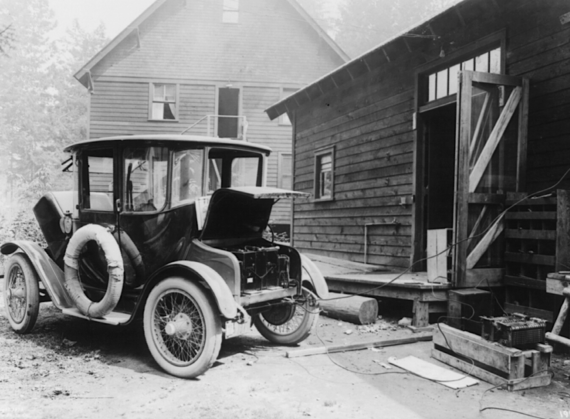The best-selling pamphlet Common Sense by Thomas Paine defined its era, the American Revolution. It inspired people in the North American colonies to fight and declare independence from the British Crown. It was merely 48 pages long, but its impact was tremendous.
In simple language Paine's text appealed to the common man. It was passionate. It was timely. It widened the public discourse. It shattered old ideas, and introduced new ones.
In President George Washington's words, his book was "working a wonderful change in the minds of many men."
To Paine, independence represented an opportunity to re-create the world. It was a chance to get rid of the old, and make way for the new. In his own words,
[W]e have every opportunity and every encouragement before us, to form the noblest, purest Constitution on the face of the earth. We have it in our power to begin the world over again... The birthday of a new world is at hand.
Six months later, on July 4th, 1776, the Declaration of Independence was ratified. Another seven years later, the Treaty of Paris in 1783 established peace between the United States and Great Britain.
A revolution or innovation can only be called in hindsight. Before it materializes as such, it needs to overcome a wall of resistance.
The Arab Spring, which began in Tunisia and later spread to Egypt, was quickly hailed as a successful movement across the Middle East toward democratization. Today we know it was not that easy.
The truth is the status quo is persistent. It takes a long time for old structures to fall apart, and new ones to reign in. There are too many profiting from the status quo.
When Alexander Graham Bell, for example, the inventor of the telephone, tried to sell his invention and patents, he was rejected.
Western Union rejected the offer because they did "not see that this device will ever be capable of sending recognizable speech over a distance of several miles." The offer, therefore, was considered as "utterly unreasonable, since this device is inherently of no use to us."
Eventually though the telephone replaced the telegraph. Something that Austrian economist Joseph Schumpeter would denote as "creative destruction."
When American journalist Walt Mossberg asked Steve Jobs at the D8 conference in 2010, about the future of the tablet, Jobs made an analogy,
"When we were an agrarian nation, all cars were trucks, because that's what you needed on the farm. But as vehicles started to be used in the urban centers, cars got more popular."
Then he paused, looked at Walt, and firmly said,
"PCs are going to be like trucks. They're still going to be around, they're still going to have a lot of value, but they're going to be used by one out of X people."
Today tablets ship in higher volumes than mobile PCs and the trend is set to continue. This, however, was not so obvious when Jobs introduced the iPad in 2010. The product polarized. When Bill Gates was asked about what he thought of the iPad, he said,
You know, I'm a big believer in touch and digital reading, but I still think that some mixture of voice, the pen and a real keyboard -- in other words a netbook -- will be the mainstream on that... It's a nice reader, but there's nothing on the iPad I look at and say, 'Oh, I wish Microsoft had done it.'
As venture capitalist Ben Horowitz points out, "the trouble with innovation is that truly innovative ideas often look like bad ideas at the time. That's why they are innovative -- until now, nobody ever figured out that they were good ideas."
Innovation in the automobile industry has stalled for decades. There have been incremental improvements, but few disruptions. When Tesla Motors brought its shares to the NASDAQ on June 29, 2010, it was the first American car maker since Ford Motor Co. went public in 1956.
Gasoline cars are pervasive. They have taken us a long way to where we are. Over the last century one American car maker, General Motors, turned out over 400 million gasoline cars and trucks. But they are the "trucks" in Jobs's analogy. They represent the status quo.
Electric vehicles represent the challenge to the status quo. For a long time they were seen as "slow and ugly, with low range, like a golf cart." But that perception is changing, thanks to Tesla and Elon Musk.
The history of the electric car begins in the 19th century. The first electric car was built in the United States in 1891 by William Morrison. By 1897, New York taxis got electrified by the Electric Carriage and Wagon Company of Philadelphia.
The Hartford Electric Light Company proposed a recharging infrastructure as early as 1896. It sought to remedy the range issues of electric cars. The consumer would buy the vehicle without a battery through GVC, a subsidiary of General Electric and Hartford provided the electricity.
At the turn of the century, the electric car was so popular that more than one third of all vehicles were powered by electricity. The New York Times acknowledged the "great advances" that the electric vehicle had made and hailed its "quiet operation" as a great advantage.
And then it all stopped.
By the 1920s, America had developed a better system of infrastructure. This meant that vehicles needed to go longer distances. The discovery of large petroleum reserves had reduced the price of gasoline. This made the gasoline car more attractive to consumers.
Henry Ford introduced the Model T in 1908 for $850. The popular equivalent by Anderson Electric cost more than twice as much. By 1915, Ford had cut the price almost by half, thus making the gasoline car more affordable to ordinary people. The gasoline car had won the battle, for now and the rest of the 20th century.
What led to the decline of the electric car?
1. Cost and speed
2. Inconvenience in recharging
3. Short range
Just three years into the new century, in 2003, Tesla, a technology and design start-up led by Elon Musk, staged the renaissance of the electric car. The purpose, in Musk's words, is "to help expedite the move from a mine-and-burn hydrocarbon economy towards a solar electric economy, which I believe to be the primary, but not exclusive, sustainable solution."
The strategy of the company was to enter the high end market, "where customers are prepared to pay a premium, and then drive down market as fast as possible to higher unit volume and lower prices with each successive model."
The master plan, that Musk shared in one of his early blog posts, therefore, included to:
1. Build a sports car.
2. Use that money to build an affordable car.
3. Use that money to build an even more affordable car.
4. While doing above, also provide zero emission electric power generation options.
In order to execute on that plan, Tesla had to overcome many barriers, obstacles and resistance. But Musk and his team pragmatically found a way to get from here to there. At nearly every turn they proved the critics wrong.
Even Bob Lutz, former chairman of General Motors, and staunch opponent of the electric car when Tesla launched, said that he owed them "a debt of gratitude for having broken the ice."
When legendary investor Warren Buffett was asked by students what he thought of the peak oil theory, he said that he believed that in twenty years all cars on the road will be electric.
Today, in terms of cost and speed, gasoline cars have little to no competitive edge over electric cars. Electric vehicles are much more affordable than they have been historically. There may not be a compelling electric car for the masses yet, but if you study Musk's master plan, you will notice that this is in the making.
Is it still inconvenient to recharge your electric vehicle? Not really. Meanwhile gasoline car owners spend thousands of dollars and hundreds of minutes every year at the gas station. The average electric car owner will charge their electric cars at home overnight. They just don't drive that much on a daily basis.
There is even a solution for frequent travelers. It's called Supercharger. If you currently own a Model S, you can travel for free across North America and Europe using the Supercharger network. In twenty minutes you can charge half of your car's battery. This is just the beginning. With Tesla opening up its patents, this may be the solution for an industry standard for charging stations.
Instead of going to the gas station, drivers of the future will charge cars as people charge smartphones today.
It may not be feasible for everyone to switch to an electric car given the constraints today. But over time as these constraints will be removed, it will make less sense to choose a gasoline over an electric car.
Electric cars don't impose the externalities that gasoline cars do. They don't have the operating costs of gasoline vehicles. That means no smog check or oil changes.
Leading electric car vehicles such as the Model S are among the safest cars in the world. The Model S has been awarded the best safety reading from the National Highway Traffic Safety Administration. That is the best rating of any car that has ever been tested in history.
When the Model X was unveiled, Musk said that the Model S can be seen as a platform as much as a vehicle. This enables Tesla to "create many cars and bring other cars to market fast."
When Jobs finished his analogy in his conversation with Mossberg, he began to smile. Being aware of the transformation that was undergoing, he understood that there was no point in resisting it. The only way was to embrace it. But he said,
"This transformation is going to make some people uneasy... when it really starts to happen, I think it's uncomfortable for a lot of people because its change."
The transformation toward a solar electric economy will also be uncomfortable. There will be a lot of people at unease. But as much as we want to fight it, embracing change is the only smart thing to do.
William Gibson pointed out, that the future is already here, but it is just not evenly distributed yet. The future of electric cars may be here, but the road toward its completion is still long. In the meantime, gasoline cars will be around. They will offer value to society. But eventually they will be eclipsed by electric cars.
Will Tesla be leading that transformation? Who knows. They have so far. Will it happen in five or twenty years? Who knows. But one thing is clear. We are heading in that direction.
This piece was originally published on Medium

